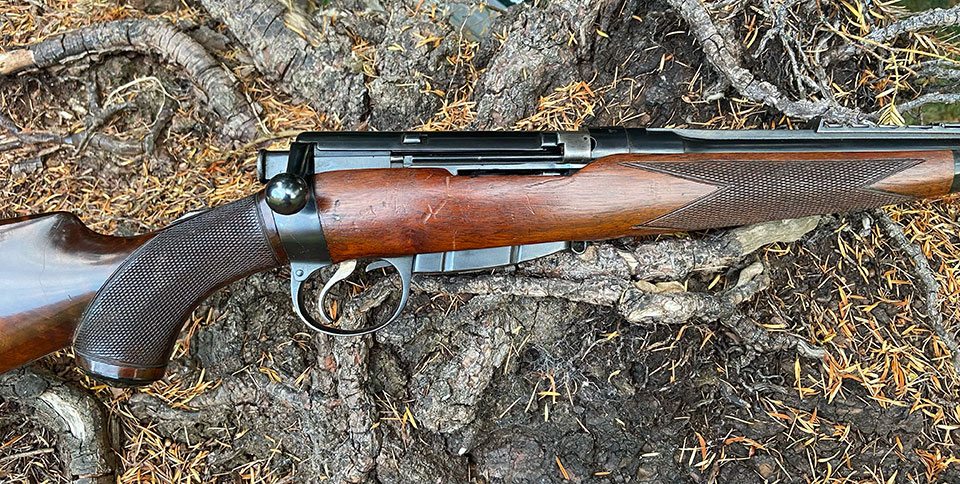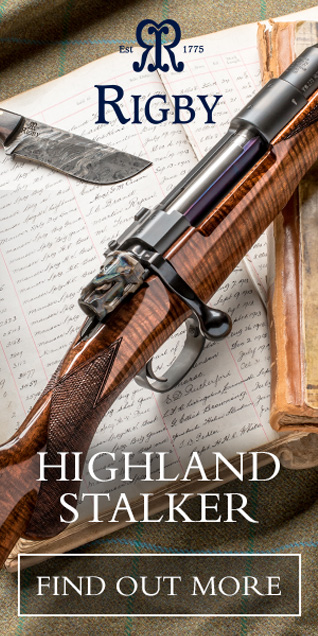The Rigby brand is probably most accessible to the shooting public in Britain through its ‘Highland Stalker’ sporting rifle, based on the original ‘Mauser Sporting’ model which made its debut in 1898.
The first of them was a ’Mauser Sporting Best’, serial number 1000, sold to a ‘Capt. D. O. Eustace’ on March 11th 1898. It was a 7lbs 6oz rifle with a 24” barrel and leaf sights out to 300 yards. The calibre is listed as .276”, as many early 7mm Rigby-Mausers are.
However, when the Rigby Mauser was introduced it was by no means the only magazine rifle option sold by the company.
a standard magazine rifle was about a fifth of the cost
When magazine rifles were first marketed to British sportsmen, they came with some useful advantages over the traditional double rifles of the day. Firstly, they cost less money. In fact, a standard magazine rifle was about a fifth of the cost of a best double.
Secondly, they offered the rapid firing of four or five shots in succession. Granted, the second was not as quick to get-off as would be the case with a double rifle but for many situations that multi-shot capacity was an advantage.
Thirdly, they were much more accurate, especially at longer ranges. This may not be as crucial in a close-range hunt for buffalo but when shooting antelope or deer at a distance it was a distinct improvement.
While sportsmen know well the .275 Rigby Mauser, it is notable that the Mauser rifle was available in a wider range of cartridge choices, with the .303 being popular for many years with British customers, as ammunition for it was widely available due to its adoption by the armed forces as a service weapon.
Not only did Rigby sell Mausers in various chamberings, they sold 6.5x53R Mannlichers, 6.5x54 Mannlicher-Schoenauers, Lee-Speed .303 and .375 sporters (often listed as ‘Lee-Rigbys’), Martinis and different types of break-action rook rifles.

The records of these can be found in one of Rigby’s serial number books. The book contains what one might consider ‘normal’ Rigby production, starting in 1883 and running until 1897. The last fifty pages contain what the heading describes as: ‘Sold by, guaranteed by & other plain guns, also rook, martini-Rigby, Mauser, Mannlicher & Lee-Rigby & other plain rifles & revolvers”.
The record of these rifles runs from serial Number 1000 to serial number 1999, which was a Mauser Sporting Best .275, sold on September 30th 1903. A new book was started to record serial number 2000 onwards. This is dedicated to magazine rifles only. Perhaps this is when Rigby decided that they deserved a special status.
there was the potential for a lucrative trade in these new magazine rifles
Rigby clearly decided in 1898 that there was the potential for a lucrative trade in these new magazine rifles and that it could sell a lot more of them than it could best doubles, which were out of the price range of many and which took longer to make.
While some work was no-doubt done in London turning Mauser models into different grades of rifle, customising them and instilling a more English style to them, many of the other types were simply engraved with Rigby’s name and address on the barrel and assigned a serial number.
Actually, not all were given a Rigby number, some were recorded in order of sale with the manufacturer’s serial number as the only point of reference. This can make them hard to search for. They are recorded in another book, which begins a with Rigby Mauser No.2000 in the front, while the rifles with non-Rigby serial numbers are listed from the back.
a Rigby serial number will enhance the desirability
Today, a passionate community of Rigby collectors seeks out anything with Rigby on it, which has raised the prices achieved for even these more mundane ‘sold by’ continental rifles. The presence of a Rigby serial number will enhance the desirability and therefore the likely price paid for a rifle of this type, but recent market activity has suggested that the mere presence of Rigby’s name on an otherwise ordinary magazine rifle will elevate its status.
I expect there are collectors who would like a Rigby-Mauser, a Rigby-Mannlicher, a Lee-Rigby and a Rigby-Martini to make up a full set of pre-war Rigby magazine rifles. To have one in each calibre variant would be better still.

Holt’s, the auctioneers in Norfolk, have featured some vintage examples in recent sales. In December 2024 there was a Rigby-Mannlicher in 6.5x53R (which is now an obsolete calibre), a Rigby-Mauser in .303 and a Rigby-Mauser in .275 (not to mention a more modern Rigby Mauser in .270, made in 1981).
This type of rifle is attractive to some collectors as it will work as a modern stalking rifle. It may be necessary to hand load ammunition for some and to work-out and sight-in at the range until the desired performance and accuracy is achieved, but they are somehow quite accessible and may appeal more to a younger demographic of collector who may be unable to pay the prices the hand-build doubles sell for and who may consider them to be ’practical classics’; less intimidating to actually use.
Published by Vintage Guns Ltd on




